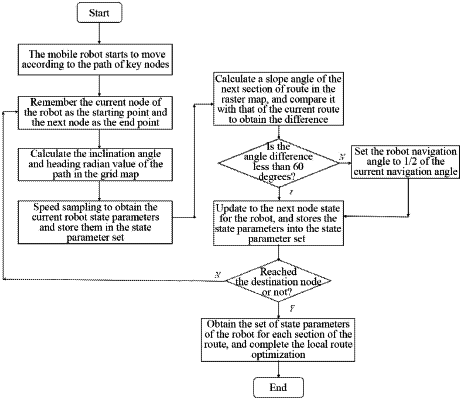| CPC G05D 1/0274 (2013.01) | 3 Claims |

|
1. A method for route optimization based on dynamic window and redundant node filtering, performed by a processor, comprising:
S100: by using an existing raster map data set, determining coordinate information of a starting position and a destination position of movement, and marking a destination node and an obstacle node in the existing raster map;
S200: using A* algorithm to plan a global route, to obtain a route node set;
S300: performing a global optimization to the global route planned by the A* algorithm, to filter redundant nodes;
S400: by combining the dynamic window algorithm, performing a local optimization section by section on the global route optimized in S300 so as to obtain a final global rout; and
S500: controlling a mobile robot to move from the starting position to the destination position based on the final global route; wherein
performing the global optimization to the global route planned by the A* algorithm to filter the redundant nodes in S300 comprises:
S310: labeling the route node set that is obtained in S200 as P{Pi, 1≤j≤n}, wherein P1is the starting point of the route and Pn is the end point of the route; creating a key point set U{P1, Pn}for storing key nodes after route optimization;
S320: for the node set P{Pi, 1≤j≤n}, setting m=2, 3, 4, . . . n, connecting in sequence from P1 to P2, P3, . . . , and Pm, when any obstacle node exists between a straight line P1Pm, taking the node Pm−1 as a required node of the route; when the straight line P1Pm does not pass through the obstacle node, determining that the node Pm−1 is a redundant node;
adding all of the required nodes to the set U; wherein after the selection of key points is done, U{P1, Pm−1, . . . , Pm+k, Pn}(2≤m≤n, 1≤k≤n−m) contains all key nodes; when a number of nodes in U is r, the set U is represented as U{P1, P2, . . . ,Pr}, (1≤r≤n);
S330: connecting all nodes in the set U in sequence to complete the global optimization of the route.
|